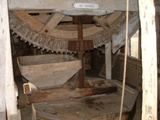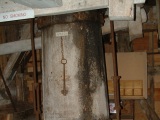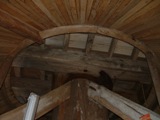Virtual Tour
Open the virtual tour in a new window.
Booklet
A 72-page booklet on the mill, written by Martin Bates and entitled "Argos Hill Windmill: How She Worked", is now available to download here.
Scale Model
David Manners has produced a magnificent 1:25 replica scale model of Argos Hill Windmill which is going to be put on display within the mill. David has written a booklet entitled "Argos Hill Windmill: Creating a scale model" which is available to view here.

Design
Argos Hill Windmill is a post mill, which means that its whole body turns 360 degrees around a central post to face the wind. It has three floors within the mill body and a one-story roundhouse at the base.
The windmill has a number of important features that are either very rare or unique:
2. The fantail is fitted to the tailpole rather than the steps. There is only one other example of this arrangement still in existence (at Jill mill, Sussex).
3. The bin attic ladder rises through a butress-like tunnel, which is unique to this mill.
4. The main post is made up of four pieces of pine (instead of the more common solid oak post)
5. Rollers are fitted around the main post to help the mill turn to wind.
6. There is a unique lock on the spout floor. There are no other known examples of this in the world.
The main design features are described in detail below:
Bin Floor

The sack hoist is also found on this floor.
Stone Floor

There are two pairs of stones - one Peak and one French Burr. The Peak stone is run from the brake wheel while the French Burr is run from the tail wheel - both connected via a quant and stone nut. There is also a wheat cleaner, a flour dresser and a grind stone (for sharpening mill bills) on this floor.
who makes the best rolex daytona uomo rolex calibre 7750 m116505 0009 16mm is going to be original choice for high-end folk.RDA 전자담배 탱크,a perfect blend of comfort and fashion.
Spout Floor

The massive centre post, samson head and crown tree can be viewed on this foor.
Of particular note is the unique door lock.
Roundhouse

The trestle is formed of four quarter-bars which take the weight of the mill from the centre post. They are fastened to two crosstrees which lay on four brick piers.
Sails

Each sail has 51 shutters which are automatically controlled by the striking gear. As the wind speed increases the shutters open to allow the wind to spill through, which allows them to maintain a fairly constant speed. Patent sails are regarded as the pinnacle of windmill sail design.
Fantail

The fantail drives the two wooden cart wheels on the track around the mill, to keep the sails facing into the wind.


